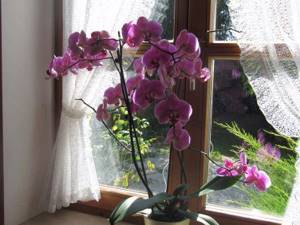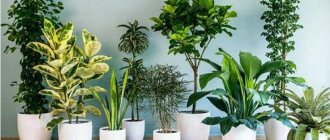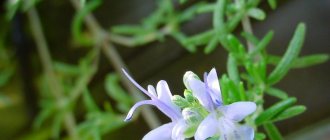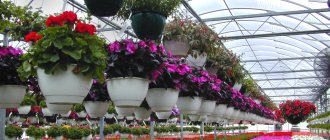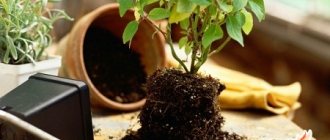Many young women would love to keep house plants, but they are afraid that they will not be able to take care of them.
In fact, there are a lot of wonderful, beautiful, unpretentious indoor plants that don’t require any special care.
Today we have made a special selection of photos for all novice gardeners so that they can see what the most unpretentious indoor plants look like.
Geranium
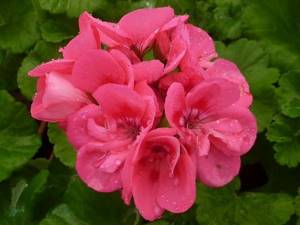
Most gardeners know it as a beautiful ornamental plant, but not everyone knows about its healing properties. Geranium flowers and leaves can repel blood-sucking insects and have a bactericidal and disinfectant effect. A decoction of pelargonium leaves is used to treat runny nose, sore throat, otitis media, bronchitis, and influenza. Geranium oil has calming properties. To prevent colds, it is recommended to chew the leaves of the plant. In this case, special care should be taken for elderly people and pregnant women, as well as those suffering from diseases of the gastrointestinal tract and cardiovascular system.
Houseplants for Beginners
Sansevieria
Among the most unpretentious indoor plants, Sansevieria, which has long had a reputation as an indestructible flower, deservedly takes first place. If you are new to growing house plants, then Sansevieria will be the best option for you to practice caring for.
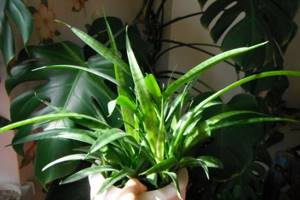
It easily tolerates both dry apartment air and the burning rays of the sun, and will not even suffer from excessive coolness, but will still protect your home from toxic substances released by synthetic finishing materials.
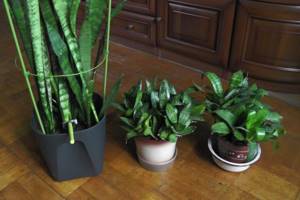
Sansevieria belongs to the agave family, replanting is not necessary for it, but you need to be careful not to allow too many roots in the clay pot, otherwise it will split.
Sansevieria is usually considered not to bloom, but some housewives who exposed them to very bright sun began to bloom. Please note that no matter how unpretentious a houseplant may be, keeping sansevieria in a very cold room for a long time can be detrimental to it.
Chlorophytum
If you choose from indoor plants for beginners, then chlorophytum is best for your first experience. It can be perfectly located in both a bright and slightly darkened room - it is classified as a sun-loving and shade-tolerant plant.
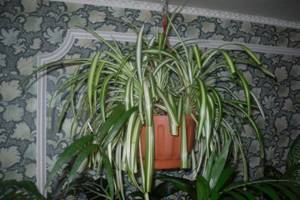
Do you need an unpretentious houseplant for your kitchen? Choose chlorophytum - it will help clear the room of smoke in a matter of minutes.
There is one thing: if you liked this flower for the bright color of its leaves, then it cannot be placed in the shade, since the variegated types of chlorophytum have lightening of the leaves.
Aloe (Aloe arborescens)
Until quite recently, every home had agave (aloe), which, as you know, is one of the medicinal plants on our windowsills. It’s great that recently the fashion for aloe has returned and it can be seen even in apartments where European-quality renovation has been done. Aloe is a typical succulent, so it needs direct sunlight and does not require frequent watering.
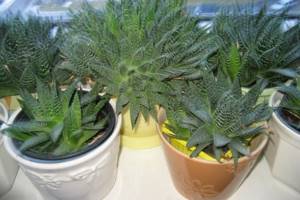
The place in the apartment for aloe is chosen to be sunny; it is best for the pot to be closer to the windows or to live on a glassed-in loggia. In winter, there is no need to create artificial lighting for aloe, as this will lead to the plant stretching and the decorative effect will be lost.
It is best to keep the agave in a cool but bright place and water it only a few times a month. Excessive watering can cause the roots to rot, leading to the death of the flower.
Cacti (Cactaceae)
They say that you can either love cacti or not notice them at all. These are desert plants, so they can be found in the most inappropriate conditions. Many cactus lovers practice them for many hours a day, but if you don’t want all this, then you don’t have to do it.
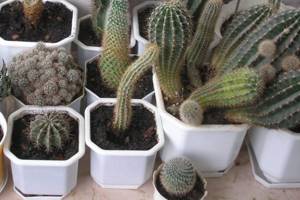
Cacti can withstand soil without fertilizers, lack of watering, and lack of light. You need to know that under such conditions you will not expect either flowers or increased growth from them. If you buy an adult specimen, you don’t have to worry that you won’t be able to take care of it. Cacti feel great even in careless owners.
Zamioculcas zamiifolia
Zamioculcas is also an unpretentious plant; it tolerates low humidity in the apartment and is not harmed by partial darkening. For a normal life, Zamioculcas needs to be kept in a bright, but without direct sunlight, calm place.
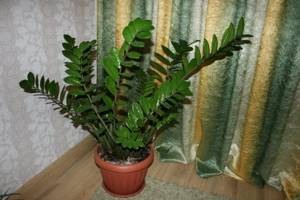
Please note that Zamioculcas does not respond well to high soil moisture. Stagnation of water is unacceptable for it, so after watering you should always drain excess water from the pan. The plant has no special requirements for soil; ordinary turf or leaf soil mixed with sand in equal proportions is suitable for it.
Podocarpus
This will be a small Christmas tree in your home . Podocarpus is an evergreen coniferous tree that will be located in the apartment as an ordinary indoor plant. Watering in summer is moderate, and in winter it is generally limited.
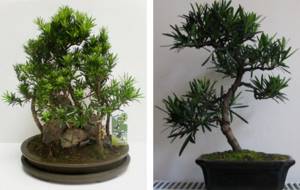
Podocarpus is very good for health: it will not only be an aromatherapy agent, but will also release phytoncides and suppress the development of pathogenic microflora in the house.
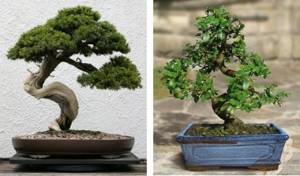
This is a very small part of those indoor plants that do not require much effort in care. They are quite enough to decorate the interior of an apartment and make it much more comfortable and cozy.
Citrus

More often than other crops, lemon and other citrus fruits are used to increase the body's resistance and immunity. Their peel, pulp and seeds contain a large amount of dietary fiber, ascorbic acid, pectin, organic acids, bioflavonoids, phytoncides, vitamins A, PP, B. Sour citrus fruits are used together with other components that improve taste and increase beneficial effects. It is recommended to use honey, ginger, aloe, garlic, and turmeric along with lemon. People with intestinal diseases, pancreas diseases, or allergic reactions should not use products containing citrus fruits.
Mint
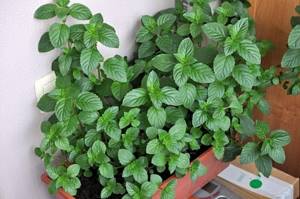
The plant has unique healing properties. Mint contains essential oils, caffeic, oleic and chlorogenic acids, betaine, menthol, flavonoids, and tannins. It contains vitamins PP, A, C, B2, B5, B6, B9. It is a natural effective antiseptic. Mint increases the activity of protective cells, has analgesic, bactericidal, and soothing properties. Inhalations with the essential oil of this plant are effective for colds, as well as for the treatment of coughs and runny nose.
The use of preparations containing mint is contraindicated for people with varicose veins, stomach diseases and low blood pressure.
Aloe
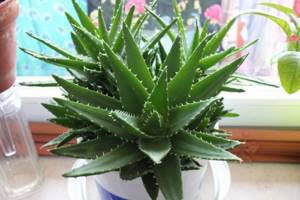
Aloe is the most ancient medicinal plant. It has been known to folk medicine for more than 2000 years. Aloe contains more than 250 active components that have a beneficial effect on the human body. The juice of the plant has antibacterial, antiseptic, restorative and immunomodulatory properties.
To increase the effectiveness of aloe preparations, it is recommended to use dried leaves. To do this, after collection, they are left for a day at room temperature. At this time, biostimulants are released in the cells, which increase the value of the healing juice.
The Wealth Gene: 4-Day Free Online Training
In 4 days you will learn the millionaire thinking method, which will help you increase your income, close your debts, and find a business you like.
Participate
To reduce bitterness, it is mixed with lemon juice or honey.
Prohibited list
Not all plants can be kept at home; this applies not only to poisonous specimens, but also to those that have a bad effect on energy. So, you can’t put milkweed at home, as it has thorns and caustic juice.
Dangerous specimens
Lilies have a tasty and tart smell, so you should not keep flowers in the bedroom. At night, they secrete a special substance that causes insomnia.
Ficus plants are not dangerous, but in some cases they cause allergies. Hydrangea has similar properties. Tuberose is also delicious and smells strong, and it gives me a headache.
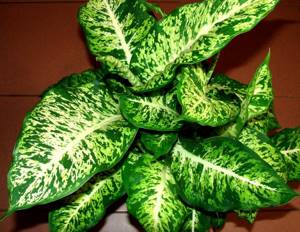
Dieffenbachia attracts attention with its bright leaves, but it is poisonous, especially to cats
Croton is also highly decorative. Elongated leaves with spots decorate any room. But as soon as the juice gets on a cut or wound, poisoning begins, and everything can end in death.
Many common plants are toxic. For example, adenium looks like a thick stem with a small number of small leaves and flowers of different colors. The sap of the plant is poisonous to both people and animals. It is an irritant, so contact with the skin can cause problems.
Monsters are rightfully considered energy vampires. They grow large and impressive. They feed on negative energy and provoke quarrels. Therefore, it is better to place such a plant in public places: offices, hospitals, schools, etc.
Eucalyptus
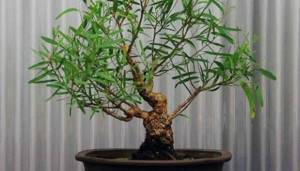
Thanks to the phytoncides, essential compounds and resinous substances included in its composition, eucalyptus essential oil is used to treat many diseases. Active components quickly restore the body after heavy loads and stress. They help cope with fatigue, weakness, and apathy.
Eucalyptus preparations are used to strengthen the immune system. The plant is considered a natural immunostimulant. In addition to essential oil, you can brew tea with leaves and drink it with honey.
Myrtle
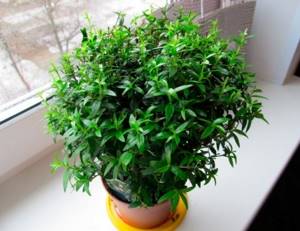
The plant grows in regions with warm climates. It has a decorative appearance and has antibacterial properties. Its effect on the body is comparable to antibiotics. An aqueous tincture of myrtle leaves has antimicrobial properties, so it is recommended to be taken for the prevention of colds by children and adults. This drug has virtually no contraindications, except for the tendency to allergic reactions, pregnancy and breastfeeding.
Healing herb for immunity Echinacea
Echinacea purpurea is a well-known healing herb for boosting immunity. It is widely used as an immunostimulant, increasing the amount of substances in the blood that enhance the activity of phagocytes - cells that absorb everything that is harmful to the body - bacteria, foreign particles, dying cells, etc.
Echinacea affects the nonspecific immunity given to us from birth, therefore it is used widely - in the complex treatment of children and adults; the substances contained in it suppress the proliferation of influenza and herpes viruses, streptococci and staphylococci, and even E. coli.
Echinacea tincture is easy to buy at the pharmacy - here we provide recipes for preparing the infusion and decoction.
How to prepare an infusion and decoction of the herb Echinacea, which improves immunity
Rosemary
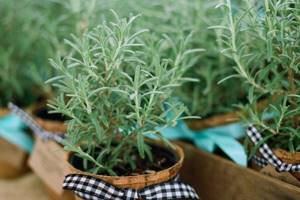
Due to its strong savory flavor, this popular plant is often used as an aromatic spice. Few people know that it contains a large amount of thymol, which has antiseptic properties. Rosemary helps quickly and effectively relieve coughs from colds and bronchitis. And also eliminate other symptoms of respiratory diseases. For medicinal purposes, rosemary is used in the form of tinctures or steam inhalations. To prevent influenza and acute respiratory infections, it is used in fresh and dried form. To restore the body's defenses, relieve stress or quickly recover from a serious illness. It is recommended to massage the areas where the lymph nodes are concentrated, or take a bath with rosemary infusion.
The essential oil of the plant increases blood pressure, so it should be used with extreme caution by people suffering from hypertension, as well as children under 7 years of age.
Laurel
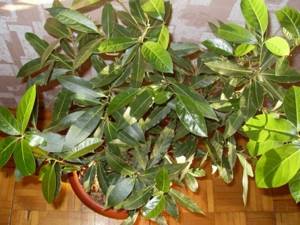
Laurel essential oil is rich in iron, potassium, manganese, zinc, copper, vitamins A, C, PP, group B. The plant has powerful antioxidant properties and helps eliminate waste and toxins from the body. In addition, it is considered a means of preventing cancer. During the cold season, it is recommended to use a decoction of laurel leaves to strengthen the immune system.
Did you like the article? Help the project!
Our team tries to make your stay on the site convenient and useful. We will be grateful if you support our project, it will help us make it even better!
Now you know which plants you want to keep at home. Thanks to their effects, you will not worry about the state of your immunity.
- Author: Inna Kiseleva
Rate this article:
- 5
- 4
- 3
- 2
- 1
(14 votes, average: 3.7 out of 5)
Share with your friends!
Phalaenopsis: tropical beauty without whims
It is a tropical orchid that requires special care. However, of all the relatives, it is the most unpretentious: the flowers are in excellent health, they bloom profusely, if you adhere to the basic rules of growing.
What will it teach? I understand that every culture is unique. Any home culture has its own requirements, and they must be implemented for the plant to grow successfully. For example, phalaenopsis requires rare watering, but frequent spraying.
